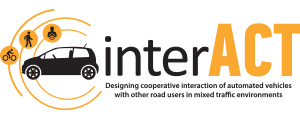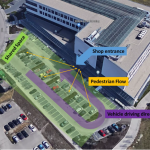Cross-cultural observation of naturalistic traffic
Implementing automated driving functions in urban traffic environments is an ambitious task – different road users pursue different goals leading to unforeseeable situations that drivers nowadays have to adapt to. This is usually done by either maneuvering around possible obstacles or by communicating ones intent to other traffic participants. This traffic interaction can be classified into two groups:
- implicit communication – this includes among others velocity, acceleration and maneuvering by drivers but also gait and body movements by pedestrians
- Explicit communication – this includes conscious behavior, which is directly visible and addressed to other road users (e.g. gestures, flashing lights)
To get a glimpse how these types of interactions currently occur in urban traffic conditions, the WP 2 partners of interACT conducted three observation studies in Athens (Greece), Leeds (UK) and Munich (Germany), enabling the evaluation of possible cultural differences in the behavior and communication strategies of all road users. Five different approaches were used to generate the data, enabling a holistic view of interactions:
- Video recordings of traffic participants
- Ground based LiDAR recordings to get velocity profiles and positions of traffic participants
- HTML based observation protocols, which observers fill out manually to describe a perceived interaction
- Questionnaires to understand the intention and perception process of pedestrians, that were interacting with vehicles
- An in-vehicle study conducted by the ICCS (Athens, Greece), in which drivers’ eye gaze was recorded. Study participants explained their perception of and intentions in various encountered traffic situations afterwards by commenting the augmented video generated while driving.
The observations are the basis for the development of psychological interaction models that yield key insights into current interaction strategies in urban traffic. These models will be used for the design of the maneuver planning, and communication strategies of automated vehicles in mixed traffic environments. Results and models will find application in the development of the Cooperation and Communication Planning Unit (WP 3) and the design of suitable HMI for successful human‐vehicle interaction (WP 4). ) of the interACT project.



